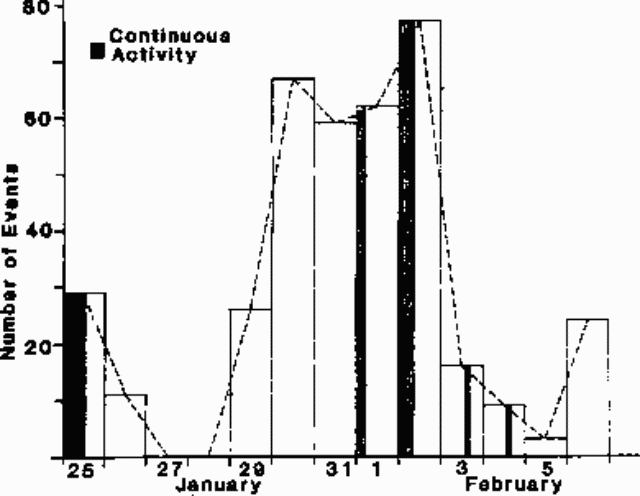Report on Santa Maria (Guatemala) — February 1985
Scientific Event Alert Network Bulletin, vol. 10, no. 2 (February 1985)
Managing Editor: Lindsay McClelland.
Santa Maria (Guatemala) Gas and ash emissions; seismicity
Please cite this report as:
Global Volcanism Program, 1985. Report on Santa Maria (Guatemala) (McClelland, L., ed.). Scientific Event Alert Network Bulletin, 10:2. Smithsonian Institution. https://doi.org/10.5479/si.GVP.SEAN198502-342030
Santa Maria
Guatemala
14.757°N, 91.552°W; summit elev. 3745 m
All times are local (unless otherwise noted)
INSIVUMEH geologists observed explosive activity and seismicity at Santiaguito during visits in late January and early February. Seven gas and ash ejections occurred on 24 January between 1230 and 1730, and 9 were seen between 0945 and 1030 the next day. Eruption clouds rose 1-2 km above Caliente vent. Similar activity has been observed during the past few months. Vigorous fumaroles were present near the vent. At El Brujo vent, on the NW side of the dome, only fumarolic activity was observed. On 8-9 February, gas and ash ejections again occurred from Caliente vent but were weaker and less frequent than in late January.
A portable seismograph was installed N of the volcano (near the Hotel Magermann) on 25 January. Very shallow B-type earthquakes accompanied the eruptions. The number of events recorded each day ranged from none 27-28 January to 77 on 2 February. Continuous seismicity was recorded for more than 11 hours on 25 January and for periods of several hours each 1-4 February (figure 3).
Geological Summary. Symmetrical, forest-covered Santa María volcano is part of a chain of large stratovolcanoes that rise above the Pacific coastal plain of Guatemala. The sharp-topped, conical profile is cut on the SW flank by a 1.5-km-wide crater. The oval-shaped crater extends from just below the summit to the lower flank, and was formed during a catastrophic eruption in 1902. The renowned Plinian eruption of 1902 that devastated much of SW Guatemala followed a long repose period after construction of the large basaltic-andesite stratovolcano. The massive dacitic Santiaguito lava-dome complex has been growing at the base of the 1902 crater since 1922. Compound dome growth at Santiaguito has occurred episodically from four vents, with activity progressing E towards the most recent, Caliente. Dome growth has been accompanied by almost continuous minor explosions, with periodic lava extrusion, larger explosions, pyroclastic flows, and lahars.
Information Contacts: E. Quévec Robles, INSIVUMEH.


